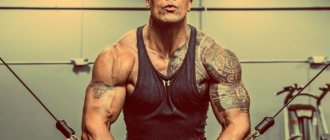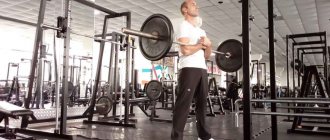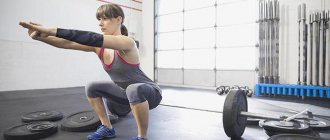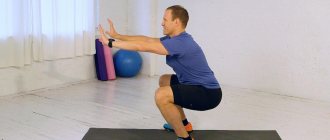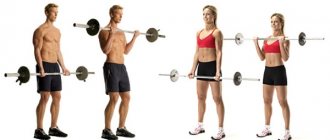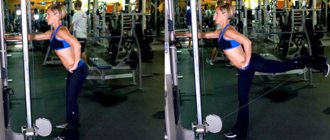Much of the advice for beginners in the gym comes down to learning and performing the vital basic exercises with free weights - such as the bench press, squats, bent-over rows, and deadlifts. At the same time, we must not forget about the possibilities and advantages of using a crossover. Unlike many types of exercises with dumbbells and barbells, the block machine provides a constant load on the muscles throughout the entire range of motion, which is great for stimulating mass gain. Using at least one crossover movement for each body part complements the effect of free weights well and represents a well-thought-out program for muscle growth. We offer an overview of exercises that are undeservedly rarely included in strength training, but give spectacular results.
Raising your arms in front of you from the lower block while sitting on an inclined bench
Targeted muscles:
- anterior head of delta;
- trapezoids.
Execution order:
- set the bench to an inclination in the range of 45°-60°;
- attach a short straight rod or cable to the block;
- take your starting position sitting on a bench and grab the barbell (cable handles), the grip width can vary from narrow to wide;
- at the beginning of each repetition, the arms should be fully straightened and a few centimeters above the hips;
- Moving only your shoulders, slowly raise your arms above your head and hold in this position for 1-2 seconds;
- slowly return to the starting position.
What does the exercise do? This angle provides maximum tension throughout the entire range of motion, which is great for stimulating the growth of the anterior shoulder muscles.
Abduction of one arm to the side while lying on a bench
Target muscles: lateral head of deltoid.
Execution order:
- install the bench so that its inclination angle is from 35° to 45°;
- grab the D-shaped handle and take a starting position on the bench, lying on your side (make sure that the position is comfortable for your legs and non-working arm);
- begin to straighten your working arm (PP), holding it a few centimeters above the surface of the thigh;
- slowly raise the PP, keeping it in line with the body, until the deltoid muscle contracts to its maximum;
- hold in this position for 1-2 seconds;
- slowly return to the starting position.
The result of the exercise . At the specified angle of inclination, new muscle groups that are not involved in the usual version of the exercise are involved in a single muscle impulse. In addition, the increased load created by the cable, both at the beginning and end of each repetition, will force the side delts to work harder than they are accustomed to.
Crossover trainer: use in gyms
In other words, it can make the breasts more beautiful and more prominent, which is why it is invariably in demand among both men and women in the gym.
What is a crossover trainer?
So, let’s take a closer look at what a crossover is and why it is needed. The crossover simulator consists of two load-block frames, standing opposite each other and connected to each other at the top by a jumper. Cables and two handles (one for each block) are stretched to the load blocks. The athlete performs the exercise by tensioning a cable with an attached weight block of the required weight.
Most often, crossovers are used in gyms. Let's return to basic and isolation exercises. Basic exercises are designed to build muscle mass, it is thanks to them that athletes “grow”. These exercises work multiple joints and multiple muscle groups, mostly barbell or dumbbell presses. Isolation exercises, such as those performed on a crossover, only work on muscle definition. They do not cover many joints and muscle groups, they only affect a specific group in isolation. More than one sane athlete cannot get by with basic exercises. Yes, you can pump up a mountain of muscles with a barbell, but then you need to somehow make this mountain aesthetically attractive. This is why the crossover was created; it gives the chest muscles a beautiful relief. At the same time, if you are new to the gym and do not have that same mountain of muscles, it is useless to approach a crossover. You won't get any effect. Better go to the barbell to build up your “base”.
Crossover simulator: exercises
In fact, with this machine you can perform one effective and relatively difficult exercise that pumps up the inner, outer and lateral parts of the chest at once.
This exercise is a hand pinch. Only the shoulder joint works here, which means that the pectoral muscles are loaded to the maximum. In addition, this exercise is recommended to be done at the end of the workout, after the basic chest exercises. It is not recommended to place it at the beginning of the complex.
The exercise technique itself is quite simple, set the required weight, go up and take one handle, go to another block and also take the handle in the other hand. We go to the center and begin to do the hands. Starting position – hands with the handles at the top, bring the hands together, in the extreme position we additionally strain the chest muscles and hold for 1 – 2 counts. That's all. But this is where the whole spectrum of possible techniques begins.
You can fasten the handles from above and bring your hands together from below, or, on the contrary, pull the handles from bottom to top. For beginners, the first option is recommended. The technique also differs depending on how you stand in the starting position. You can stand completely straight, hands shoulder-width apart, or lean forward a little and put one of your feet there, or, for example, lean forward strongly, almost 90 degrees, leaving your feet shoulder-width apart. You can also pull the handles in different ways, some bring their hands down, some in front of them. Some people do this with both hands at once, others with just one.
It is worth saying that the way you perform the exercise determines which muscles and on which sides you pump up the most.
The quality of the exercise also depends on the quality of the equipment; choose only proven equipment.
Wide-grip lat pull-down while sitting on an incline bench
Targeted muscles:
- latissimus dorsi muscles;
- rhomboid back muscles;
- teres major;
- middle part of the trapezius muscle.
Procedure for performing the exercise:
- Set the incline bench at an angle of approximately 45°;
- place the bench inside the machine,
- take a wide handle;
- take the starting position - grab the handle of the block so that your hands are wider than your shoulders, sit face down on the bench, legs back;
- pull the handle down until the bar touches your chest;
- at the bottom point of the movement, you need to slightly bend your back, move your elbows back and bring your shoulder blades together as much as possible;
- hold in this position for 1-2 seconds;
- return to the starting position.
What does the exercise do? Due to the unique angle of inclination, the entire back muscles contract very strongly, which helps to better feel the muscle connection. In addition, with this use of an incline bench there is no opportunity to impart momentum to the movement that increases fiber activation in the target muscles.
Crossover exercises for the upper body.
In our previous article, we already told you about some exercises on a multifunctional crossover trainer. Today we will take a closer look at exercises that allow you to harmoniously develop your upper body. Thanks to the use of this block simulator, you can effectively work out the arm muscles: biceps, triceps, deltoids, brachialis and other muscles, pectoral muscles, back muscles and abs.
Almost all of the exercises listed below are isolating, which means they are designed to deeply work a specific muscle group. Exercises on the upper blocks will help create a beautiful muscle relief. Most often, the crossover is used by athletes who are on a “drying” period, during which the maximum sharpening of the relief occurs. The cable-block system of the simulator allows you to keep your muscles in good shape throughout the entire exercise.
Shoulder and arm workout.
The lat pulldown is a classic exercise for working the triceps. Using a soft rope handle allows you to achieve maximum amplitude and work the deep layers of muscles.
Stand facing the machine and lean your body forward slightly, standing on “soft knees.” To improve resistance, one leg can be placed forward. Maintaining a natural arch in your lower back, straighten your chest and, while inhaling, lower the handle of the exercise machine down towards the front of your thigh. Elbows should be pressed to the body and remain static. Having reached the bottom point of the movement, hold for 1-2 counts. As you inhale, smoothly return the handle to its original position. The exercise is performed 10-15 times for 3-5 approaches.
Without changing the cable handle, perform another exercise using the upper block of the crossover - row to the chin. In this case, the posterior bundle of deltoid muscles is loaded, which is extremely difficult to work out with basic exercises.
You need to stand at a distance of 1.5 meters from the crossover, holding the rope handle in your hands. Inhaling, pull the handle of the exercise machine towards your chin. During the movement, your elbows should be higher than your forearms. At the end point of the movement, hold the position of the body, maintaining tension with the rear delts. The body is positioned level. As you inhale, take your starting position. For 1 approach, 10-12 repetitions are performed. A total of 2-3 sets of deadlifts are done.
Using a steel crossover handle, you can work your back muscles, for example, by performing lat pulldowns with straight arms. The pullover will help you get a V-shaped back by working your latissimus dorsi muscles. The grip of the handle should be wide. Take 1 or 2 steps back while facing the crossover. The stand is carried out on slightly bent knees. It is necessary to tilt the body forward slightly - about 30 degrees. Using straight arms, pull the handle toward your body. Stopping at your hips, hold the handle for 1-2 seconds. Focus on the peak muscle contraction. The return of the handle occurs while inhaling at a slow pace. To eliminate shoulder work, do not raise your arms too high. The exercise is performed in 3 sets of 15-20 repetitions.
To work the anterior head of the delta and trapezius muscles, you can perform arm raises while sitting on a bench. This exercise uses a lower crossover block as well as an incline bench.
Set the incline of the bench to 45-60 degrees. Sitting on a bench, pull the handle diagonally towards you with straight arms, so that at the highest point your arms are above your head. Hold the position of the body with the rope taut for 1-2 counts. Repeat 10-15 times. The diagonal movement will help maximize the load on the muscles and stimulate the growth of the anterior shoulder muscles.
If your goal is a beautiful lateral head of the deltoid muscle, then perform abduction of one arm to the side while lying or sitting on an inclined bench. The tilt angle should be approximately 35-45 degrees. For traction, attach a D-handle to the crossover. Take a lateral position on an incline bench and perform a one-arm bar row up. Make sure that the deltoid muscle contracts as much as possible. At the top point, freeze for 1-2 seconds and slowly return your hand to its original position. An unusual angle of inclination will help to engage those muscles that usually do not work when performing basic exercises.
When performing pulling exercises, you can use several handles at once. For example, in the exercise of raising arms to the sides from a sitting position. Thanks to this exercise, the rhomboid muscles, the posterior head of the deltoid muscle, and the middle part of the trapezius muscle are well worked out. Place a bench in the middle of the double crossover. The torso should be 30 centimeters from the blocks. Grabbing the handles, pull them to the sides until the shoulder blades on your back come together. For more intensity, try to move your elbows back and down. When you feel that your shoulder blades are connected, hold the position of your body for 1-2 counts.
Using two handles at once will also help pump the clavicular muscle of the pectoralis muscle. Change the angle of the bench to about 70 degrees, placing it in the center of the distance between the two crossovers. Grab the handles so that your shoulders are at a 70-degree angle to your torso. Lie with your back on a bench and bring your arms in front of you so that they intersect near your nose. At the top point, hold for 1-2 seconds. Then, slowly return to the starting position. This exercise, a hybrid of the crossover row and the butterfly exercise, will help pump up the upper chest.
If your goal is biceps, an exercise on the upper crossover block will help you strengthen it. In addition to the biceps, the brachialis is worked on, which visually affects the size of the biceps itself. For this exercise you will need a short and straight handle. Sit comfortably on a sports bench, fixing your legs behind the bolsters. Grab the handle with a wide grip. Lean back slightly as you lower the barbell down behind your head. At the lowest point, the biceps should be bent as much as possible. Due to the flexion of the arm, the biceps is not so much involved in the process of flexing the forearm, giving this function to the brachialis.
Triceps can also be worked on an incline bench at an angle of 45 degrees, which must be installed at a distance of 60-90 centimeters from the crossover. Sit on it so that your head faces the block. Lean your back on the bench and pull the handle towards you. In this case, your elbows should be slightly apart. At the maximum point, when the handle is approximately at the level of your eyes, pause a little and smoothly return your hands to the starting position.
Close-grip lat pull-down while standing on an incline bench
Target muscles: latissimus dorsi (focus on the lower part).
Execution order:
- adjust the angle of the bench in the range from 30° to 70° (change the set position before each approach or new workout);
- attach a V-shaped handle to the cable (if possible, try to find one that is wider than the bench at the top);
- Grasp the handle with your palms and carefully return back to the base of the bench;
- While continuing to stand, to stabilize the position, tilt your chest towards the top of the bench, place your legs behind the line of your back;
- begin to pull the handle towards the lower abdomen, slightly arching your back, keeping your elbows close to your body and your chest raised high;
- control the traction force so that the shoulder blades are brought together as much as possible.
Why do this? Performing the exercise with the bench at this angle allows you to pump up the lower part of the latissimus muscles where they come into contact with the spine. In addition, the incline bench forces you to use a narrow grip, which stimulates the growth of target muscles in thickness.
Crossover trainer. Exercises. How to choose and features
A beautiful body is the dream of many people. But what to do if you don’t have enough time to visit the gym? The answer is simple - arrange it at home. But at home, as a rule, there is not enough space to install several devices. Therefore, you should opt for multifunctional devices, one of which is a crossover simulator.
What is a crossover trainer
Externally, this device is unremarkable. This device consists of two racks (block frame) with special cables and a crossbar. The block frame is equipped with traction blocks, the weight of which can be adjusted. Using handles, cables and rollers, the blocks move in the frame along a certain trajectory, while the athlete can pull them in different directions. This makes it possible to correct the muscle relief, build muscle, pumping up the body with the help of pulling blocks at the required angle.
The load is selected depending on the athlete's level of training and can range from the minimum values used during warm-up or rehabilitation to the very significant weight required by professional weightlifters. Thus, the crossover simulator is universal not only in terms of the variety of exercises. It is suitable for both beginners and experienced athletes.
The working weight in the device changes by moving the lever that fixes the blocks. The crossover trainer is a strength device. The result is achieved through the efforts of the athlete. The very name “cross over” literally means “through everything”.
This simulator allows you to train your arms, shoulder girdle, hips, buttocks, abs, back and pectoral muscles. Just one device can replace an entire gym. At the same time, the device does not take up much space, and the design is adjustable, thanks to which each athlete can create an individual training program for himself.
The effectiveness of the exercises is not inferior to training with a regular barbell, but significantly exceeds them in terms of safety. There is no risk of losing orientation in space, dropping the projectile on your leg or injuring your back. The effect will be noticeable after a couple of weeks of effort, subject to regular exercise.
The advantages of this device include:
- Balance. When exercising with free weights, the athlete has no support. When exercising with this machine, the athlete has support that will prevent him from bending forward while performing the exercises.
- Diversity. The crossover trainer will never make an athlete get bored during training. There are an unimaginable variety of exercises that can be performed on this device. Even the same exercise can be done in several variations. You can attach various handles to the device, which will allow you to work all muscle groups of the body. Straight bars, curved handles, and rope are used as additional devices. All this is added with the aim of diversifying the training program, improving the effect of the exercises and, of course, making the exercises as convenient as possible.
- Rehabilitation. The crossover trainer is great for people who have recently been injured. It allows you to qualitatively develop your knees, arms, back and other parts of the body.
Features of training
Crossover training requires a lot of energy and maximum focus. Therefore, you should exercise on the simulator immediately after warming up. Loads are pulled using the arms or legs in the direction specified by the training program. In this case, lifting weights can be carried out with one limb.
The crossover trainer allows you to perform exercises such as:
- Raising hands. By the way, this exercise gave the device its name – crossover.
- Chest press from different angles.
- Various types of pulls - horizontal, vertical and cross.
- Bending your arms in different positions - standing, sitting or lying down.
- Squats and lunges.
- Swing your legs.
- Twisting.
The technique of using the simulator is simple. Before class, you need to select a working weight and take the starting position. When performing any exercise, the back should remain straight, moving the handle in any direction is done while exhaling.
The effectiveness of exercise depends not only on the intensity of training, but also on the correctness of the exercises. In this case, the intensity of exercise can be changed in two ways - by adjusting the weight of the loads or the number of repetitions of one exercise.
When building a training program, it is important to correctly formulate the load. You should not work on all muscles at the same time, as this will lead to overload of the body. It is recommended to divide the program into two stages - for the upper and lower parts of the body, and work on them every other day.
Exercises
As mentioned above, the crossover simulator is a universal device on which you can successfully work out the muscles of the upper and lower body.
Training the bottom
The lower body includes the buttocks and legs. To form a beautiful rounded buttock shape, you can perform exercises such as:
- Deadlift with load from the lower block.
- Squats from the lower block. This exercise is good because the maximum load is placed on the gluteal muscles, and as a bonus, on the back of the thighs. In this case, the abdominal and back muscles are involved in the work, but there is practically no load on the knees.
Raising arms to the sides in a sitting crossover
Target muscles:
- rhomboid muscles;
- middle part of the trapezius muscle;
- posterior head of the delta.
How to do the exercise:
- install a straight bench in the center of the crossover;
- Grab the D-shaped handles and sit so that your torso is about 30 cm in front of the blocks;
- working with your elbows, pull the handles to the sides until you feel your shoulder blades touch;
- to make the contraction even more intense, try to move your elbows slightly back behind your body and down;
- hold this position for 1-2 seconds, focusing on feeling the tension in each muscle in your inner back.
Purpose of the exercise . The movements will pump up and isolate the rhomboids and mid-trapezius. For other muscles involved in movement, the exercise allows for deep work in any position of the back.
Bringing your arms to your chest while lying on an incline bench
Targeted object: clavicular head of the pectoral muscle.
How to do the exercise:
- set the bench at an incline of approximately 75°;
- place it centrally inside the simulator;
- adjust the cables so that when you grip the handles, your shoulders are at an angle of about 70° in relation to your torso;
- from a standing position, lie with your back on the bench;
- clasp the handles with your palms;
- Having slightly bent your elbows, begin to bring your arms across your body and slightly upward, so that when they meet, they are approximately at the level of your nose;
- hold in this position for 1-2 seconds, squeezing and straining your pectoral muscles;
- gradually relaxing the muscles, slowly return to the starting position.
Results . The exercise is a kind of hybrid of the lower row in the crossover and the pinch of the arms in the butterfly machine. However, because it creates a unique plane in which the movement occurs, it stimulates the muscles of the upper chest (just below the collarbone) well.
Variations for the top and middle of the chest
As already mentioned, classic crossovers mostly target the lower chest. In fairness, it is worth citing variations of this exercise, the combination of which will help to maximally polish the shape of the pectoral muscles from all sides.
In general, the technique for performing the exercise remains the same, only the position of the body and the direction of pull of the cables change.
Upper chest
When our task is to draw the upper contour of the chest, the handles will need to be pulled not from top to bottom, but from bottom to top. That is, the exercise is performed on the lower block.
When using lower blocks, the load is redistributed to the upper chest.
In the starting position, the arms are slightly bent at the elbows, lowered down to the sides of the body and slightly pulled back (until you feel a stretch in the chest). Palms are directed towards the body. As you exhale, you need to raise your arms and bring them together in front of you. While inhaling, return to the starting position.
Mid chest
To work the middle of the chest, secure the blocks in the middle of the supports and perform the information directly in front of you. In this position, the arms at the end point will not be directed up or down, but forward.
Working on the central part of the chest.
You can also try a horizontal crossover. To do this, place a bench between the supports of the simulator. You lie down on it with your body and grab the handles of the blocks in the lower position. The load will be similar to what you get when doing dumbbell curls. However, thanks to the resistance of the simulator, your muscles will not relax for a second, that is, the workout will be even more powerful.
Execution on a horizontal bench.
Biceps curl from the upper block in the simulator
Target muscles:
- shoulder (brachialis);
- biceps.
Procedure for performing the exercise:
- install a short straight barbell (straight handle) on the vertical block of the simulator;
- sit on a bench and put your feet under the bolsters;
- grab the handle with a wide, straight grip (make sure your arms remain straight before starting each rep);
- lean your body back slightly as you lower the barbell down and back behind your head, but do not use your body momentum;
- make sure that the biceps are strongly bent at the bottom of the movement;
- hold for 1-2 seconds;
- slowly return to the starting position.
Why do this? Because this movement raises the elbows above eye level, the biceps becomes a less powerful forearm flexor. This engages the brachialis underneath the biceps, which in turn stimulates the hypertrophy of this muscle. By increasing the mass of the shoulder girdle, the biceps will be “pushed” upward, creating the illusion of a higher peak when the arm is curled.
Triceps extensions lying on an incline bench
Target muscles: triceps.
Procedure for performing the exercise:
- set the bench to an inclination angle of approximately 45°;
- install the bench in the crossover so that the distance between its end part and the center of the machine is 60-90 cm (when you lean back on the bench, your head should be closer to the weight than your legs);
- Attach a horizontal handle or rope handle to the cable, which must be interchanged before performing each new approach or at the beginning of the next workout;
- sit down and lean back on the bench, ask the assistant to give you the handle;
- elbows spread out to the sides should be in line with the torso (they must be held in this position throughout the entire set);
- Instead of lowering the handle straight down, you will have to perform a movement that combines elements of extension and thrust at the same time;
- continue the movement until the muscles contract completely and hold this position for 1 second;
- slowly return to the starting position.
Result : the exercise, being a combination of triceps rows and extensions, combines the best of them in terms of enhanced impact on the triceps.
Bent-over arm extension on a lower block
Target muscles: triceps.
Procedure for performing the exercise:
- grab the end of the cable of the upper block (preferably the tip);
- bend towards the floor at a right angle;
- bend your legs slightly, place the elbow of your non-working arm on your knee;
- hold the cable so that the movement can be performed with a hammer grip;
- starting with the triceps, at full stretch, slowly straighten your elbow until your arm is straightened and the triceps are fully contracted;
- hold in this position for 1-2 seconds;
- return to the starting position.
Why do this? The unique positioning of the arm and torso makes this exercise similar to concentrated biceps hammer curls. When the movement is performed absolutely correctly, the triceps muscles contract extremely strongly, which ensures rapid mass growth.
Bicep curls while sitting on an incline bench
Target muscles:
- biceps;
- brachialis.
Procedure for performing the exercise:
- give the bench an inclination angle of approximately 45° and place it in front of the upper crossover block;
- Attach a horizontal handle to the cable (or a rope handle if you want to perform hammer bends);
- grab the handle and lie with your back on the bench;
- at the beginning of each repetition, the arms should be straight and directed upward towards the block;
- Without using your shoulders or forearms, slowly pull the cable towards your forehead, continuing this movement until it touches;
- Flexing your biceps as hard as possible, hold the peak contraction for 1-2 seconds;
- slowly return to the starting position.
Why do you need to do the exercise? As your arms are extended in front of you, the traction will act on the brachialis, stimulating its growth. The increase in biceps directly depends on this factor. Thus, the brachialis plays the role of the “great mass builder.” In addition, strict adherence to the exercise technique provides a powerful, unparalleled contraction of the biceps, which leads to a rapid increase in its volume.
Crossover squats
Target muscles:
- quadriceps;
- buttocks.
Performing the exercise:
- grab the horizontal handle or cable attached to the lower block and step back;
- when the weights, having risen, create tension in the cable, keeping your arms straight, squat down, as if you were sitting on a low bench behind your buttocks;
- when your thighs are parallel to the floor (or just below this point), hold in this position for 1 second;
- Stressing your quadriceps and glutes as much as possible, slowly return to the starting position.
Why do this? The exercise is an excellent alternative to squats in various machines and basic squats. Its peculiarity is that the load on the muscles when squatting is distributed from the bottom up, and not from the weight on the upper back.
Back exercises
An effective exercise is a pullover from the position of the upper block (exercises from the “traction” category). Involves all back muscles with emphasis on the latissimus. This exercise helps to create a beautiful, muscular and proportional back.
- We use a handle or bar for deadlifts.
- Facing the frame, we take the handle in the position from above. Arms are straightened. Legs in a light squat position. We move the body back.
- Let's take a breath. As you exhale, using only the back muscles, lower the bar until it contacts the hips, fix the position for a few seconds.
- As you exhale, we return to the starting position.
Important!
- do not allow your elbows to bend. This transfers the load from the back to the biceps.
- Avoid straightening or excessively arching your back.
We perform 3-4 approaches 10-12 times, depending on the level of training and working weight.
There are also the following types of pullover in a crossover:
- traction of the upper block while sitting forward;
- lat pulldown while sitting back.
The peculiarity of the technique is that traction is also performed using the back muscles, but it is necessary to control especially carefully so that the load does not transfer to the shoulders and arms. The shoulder blades should be completely brought together and fix the position of the back for 2-3 seconds.
Deadlift from the lower block
Targeted muscles:
- biceps femoris muscle;
- buttocks.
Procedure for performing the exercise:
- grab the horizontal handle or cable attached to the lower block and step back;
- wait until the weights rise and create tension in the cable;
- With your knees slightly bent, your lower back arched and your buttocks pulled back, lower your body down until you feel a deep stretch in your hamstrings;
- hold in this position for 1-2 seconds;
- slowly return to the starting position;
- At the end of each rep, arch your lower back and squeeze your glutes.
Why do this? The exercise is a worthy alternative to the traditional straight-legged deadlift with a barbell or dumbbells. When performing it, constant tension is created throughout the entire amplitude of movement, which improves the neuromuscular activity of the target muscles, and also gives a powerful pump to the hamstrings and buttocks.
“The Reliable Dozen” is what these 12 exercises are called. With strict adherence to technique and the athlete’s concentration on goals, the “dozen” always gives amazing results.
Execution technique
Often in isolated exercises, technique plays a more significant role than the weight itself. Crossover is no exception. Our task is not to load the muscle to the maximum (there are basic exercises for this), but to make it work so that it grows in the way we need. Well, or in the case of using exercises for finishing, we are working with an already tired muscle, so heavy weights are also irrelevant.
Let's look at the crossover in its classic form, leaving the variations for last.
- Set the required weight on the machine. It should be the same on the right and left. Use a load that will allow you to perform movements completely under control, without jerking.
- Stand straight between the posts, bend slightly forward with your back straight. Place your feet shoulder-width apart, knees slightly bent. Some athletes put one leg forward for a more stable body position when bending over. This approach has its place, however, when using it, it is necessary to alternate the position of the legs from approach to approach. This will avoid asymmetry of the load on the right and left sides.
- Raise your hands and grab the handles of the blocks so that you feel a stretch in your pectoral muscles. The elbows should be bent (this rule remains the same throughout the entire movement), the shoulder blades should be pressed tightly against the back. Lock yourself in the starting position.
- As you exhale, without bending your back or changing the angle of your elbows, slowly and under control bring your arms together below you in front of you. The insides of your wrists should be facing each other. Concentrate on maximizing the strength of your pectoral muscles. At the bottom of the exercise, hold for 1-2 seconds. You can even slightly move one hand behind the other (alternately) to increase the amplitude.
- As you inhale, raise your arms again to the starting position.
The classic version of the crossover emphasizes the load on the lower chest.
When performing the exercise, do not allow your elbows to straighten. The angle of about 10 degrees is maintained all the time. With the correct technique, the trajectory of the brushes' movement resembles a semicircle. The back should remain straight at all times. Shoulders should be straightened.
It is also important to control muscle effort and not allow yourself to work with your arms. We train specifically the pectorals, remember this. Avoid jerking - the movement is carried out evenly, the muscles do not relax for a second.


